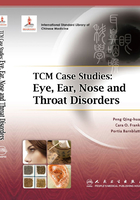
上QQ阅读APP看书,第一时间看更新
Chapter 11 Pterygium
A pterygium is a triangular thickening of the conjunctiva that grows out from the inner canthus into the cornea. 1 It can grow large enough to interfere with vision. Its exact cause is not understood, but it occurs more frequently if there has been prolonged eye irritation from wind, dust, or the sun. It occurs more frequently in people who spend significant time outdoors. Treatment consists of eye drops to manage dryness and discomfort, and to relieve irritation. If the pterygium blocks and covers the pupil, afecting visual acuity, then surgery to remove the membrane will be performed. 2
In TCM, pterygium is called nŭ ròu pān jīng (胬肉攀睛, excrescence creeping over the eye). It is also referred to as leech accumulation, lung stasis patern and pathogenic invasion of the extra channels. The possible etiologies of this condition are numerous. Patterns associated with pterygia include accumulated heat in the heart and lung, atack of external wind heat, a combination of internal and external pathogens, static heat with blood stasis and congestion in the collaterals. Other contributing factors include excessive consumption of spicy food or alcohol causing heat congestion in the spleen and stomach, and leading to the stagnation of pathogens in the canthus. Anxiety, excessive anger and emotional distress can cause qi stagnation transforming into fre, and heart fre ascending to counter-atack lung metal, leading to pterygia. Overwork and over-indulgence in sexual activity can damage heart yin and kidney essence, potentially inhibiting water’s ability to control fire and leading to upward burning of deficient fire and congestion in the collaterals. The etiologies of this condition are largely related to an imbalance of the heart, lung, kidney, spleen and stomach organs. This disease has both excessive and defcient paterns.